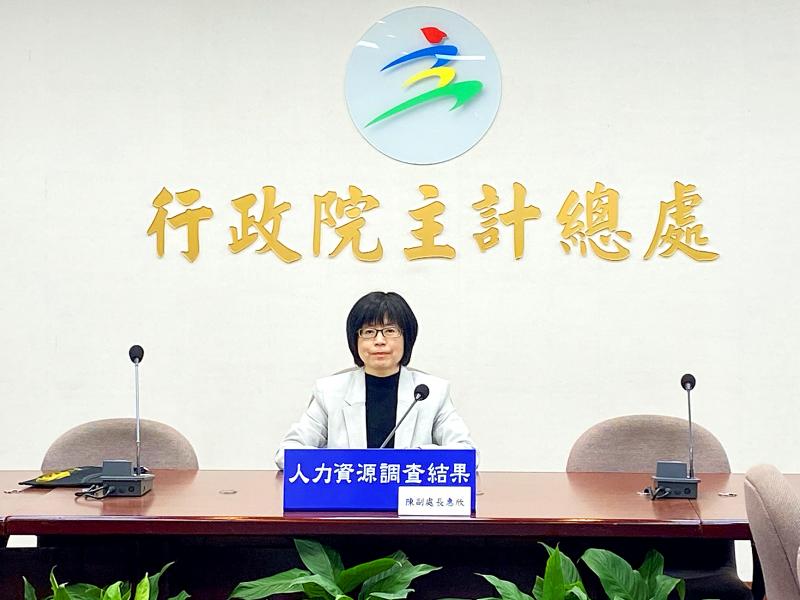The nation’s unemployment rate last month dropped to 3.66 percent, falling for the sixth straight month, as fewer people quit their jobs, but slightly more than left seasonal or temporary positions, the Directorate-General of Budget, Accounting and Statistics (DGBAS) said yesterday.
The rate was the lowest in 12 months, but remained at a four-year high for January, as the job market has not yet fully recovered from the COVID-19 pandemic, DGBAS Deputy Director Chen Hui-hsin (陳惠欣) told a media briefing.
“Unemployment usually declines in January, but could rise this month as people disatisfied with their jobs tend to move on after receiving their year-end bonus,” Chen said.

Photo: Cheng Chi-fang, Taipei Times
This trend was disrupted last year as the COVID-19 outbreak weakened economic activity and people did not seek new positions over economic fears.
The jobless rate after seasonal adjustments held steady at 3.75 percent, suggesting a stable market, Chen said.
The number of jobless people shrank by 0.52 percent, or 2,000, to 438,000 last month, the agency’s monthly report showed.
While about 3,000 fewer first-time jobseekers entered the market and about 1,000 fewer people entered after quitting their jobs, 2,000 people left their temporary positions, it showed.
The labor participation rate was 59.14 percent, unchanged from December last year and down 0.07 percentage points year-on-year, it said.
The unemployment period averaged 22.2 weeks, longer than the 22.1 weeks one month earlier, it said, adding that the period for first-time jobseekers shrank to 21.1 weeks.
People with university degrees had the highest unemployment rate at 5.33 percent, followed by high-school graduates at 3.35 percent and people with other graduate degrees at 2.86 percent, the report showed.
People with a junior-college education had the lowest unemployment rate at 2.5 percent, followed by those with a junior-high school education at 2.67 percent, it showed.
People aged 20 to 24 had the highest unemployment rate at 11.96 percent, followed by 15 to 19-year-olds at 8.4 percent, 25 to 29-year-olds at 6.22 percent and 30 to 34-year-olds at 3.58 percent, the report showed.
People aged 45 to 64 had the lowest unemployment rate of 2.16 percent, it showed.
The nation’s unemployment rate is lower than South Korea’s 5.7 percent, Hong Kong’s 6.5 percent and Germany’s 4.4 percent, but higher than Japan’s 2.8 percent, government data showed.

The US dollar was trading at NT$29.7 at 10am today on the Taipei Foreign Exchange, as the New Taiwan dollar gained NT$1.364 from the previous close last week. The NT dollar continued to rise today, after surging 3.07 percent on Friday. After opening at NT$30.91, the NT dollar gained more than NT$1 in just 15 minutes, briefly passing the NT$30 mark. Before the US Department of the Treasury's semi-annual currency report came out, expectations that the NT dollar would keep rising were already building. The NT dollar on Friday closed at NT$31.064, up by NT$0.953 — a 3.07 percent single-day gain. Today,

‘SHORT TERM’: The local currency would likely remain strong in the near term, driven by anticipated US trade pressure, capital inflows and expectations of a US Fed rate cut The US dollar is expected to fall below NT$30 in the near term, as traders anticipate increased pressure from Washington for Taiwan to allow the New Taiwan dollar to appreciate, Cathay United Bank (國泰世華銀行) chief economist Lin Chi-chao (林啟超) said. Following a sharp drop in the greenback against the NT dollar on Friday, Lin told the Central News Agency that the local currency is likely to remain strong in the short term, driven in part by market psychology surrounding anticipated US policy pressure. On Friday, the US dollar fell NT$0.953, or 3.07 percent, closing at NT$31.064 — its lowest level since Jan.

Hong Kong authorities ramped up sales of the local dollar as the greenback’s slide threatened the foreign-exchange peg. The Hong Kong Monetary Authority (HKMA) sold a record HK$60.5 billion (US$7.8 billion) of the city’s currency, according to an alert sent on its Bloomberg page yesterday in Asia, after it tested the upper end of its trading band. That added to the HK$56.1 billion of sales versus the greenback since Friday. The rapid intervention signals efforts from the city’s authorities to limit the local currency’s moves within its HK$7.75 to HK$7.85 per US dollar trading band. Heavy sales of the local dollar by

The Financial Supervisory Commission (FSC) yesterday met with some of the nation’s largest insurance companies as a skyrocketing New Taiwan dollar piles pressure on their hundreds of billions of dollars in US bond investments. The commission has asked some life insurance firms, among the biggest Asian holders of US debt, to discuss how the rapidly strengthening NT dollar has impacted their operations, people familiar with the matter said. The meeting took place as the NT dollar jumped as much as 5 percent yesterday, its biggest intraday gain in more than three decades. The local currency surged as exporters rushed to